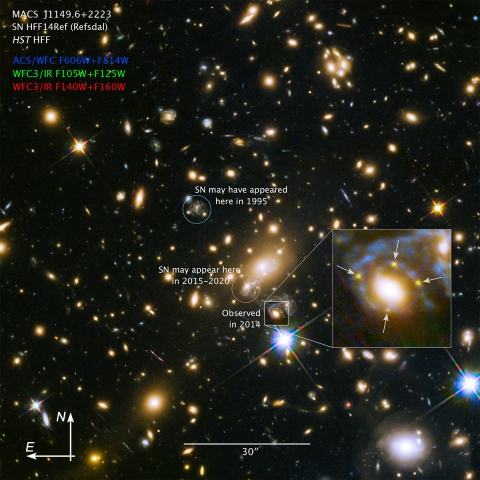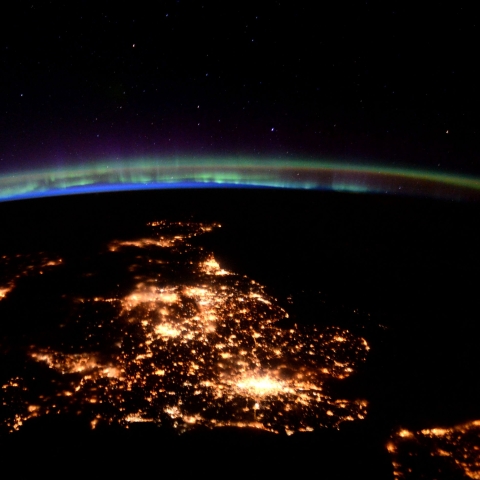

Research led by an international team of scientists could help more accurately determine the Universe’s age
12 May 2023
5 min read
Researchers from across the globe have used a first-of-its-kind technique to measure the expansion rate of the Universe, providing insight that could help more accurately determine the Universe’s age and help physicists and astronomers better understand the cosmos.
The data from a magnified, multiply imaged supernova, which was discovered by a team of astronomers, including Dr Or Graur at the University of Portsmouth, provides insight into a longstanding debate in the field and could help scientists more accurately determine the Universe’s age and better understand the cosmos.
In astronomy, there are two precise measurements of the expansion of the Universe, also called the “Hubble constant.” One is calculated from nearby observations of supernovae, and the second uses the “cosmic microwave background,” or radiation that began to stream freely through the Universe shortly after the Big Bang.
However, these two measurements differ by about 10 per cent, which has caused widespread debate among physicists and astronomers. If both measurements are accurate, that means scientists’ current theory about the make-up of the universe is incomplete.
Patrick Kelly, lead author of the research and an assistant professor in the University of Minnesota School of Physics and Astronomy, said: “If new, independent measurements confirm this disagreement between the two measurements of the Hubble constant, it would become a chink in the armor of our understanding of the cosmos.
“The big question is if there is a possible issue with one or both of the measurements. Our research addresses that by using an independent, completely different way to measure the expansion rate of the Universe.”
The University of Minnesota-led team was able to calculate this value using data from a supernova discovered by Kelly in 2014—the first ever example of a multiply imaged supernova, meaning that the telescope captured four different images of the same cosmic event. After the discovery, teams around the world predicted that the supernova would reappear at a new position in 2015, and the University of Minnesota team detected this additional image.
These multiple images appeared because the supernova was gravitationally lensed by a galaxy cluster, a phenomenon in which mass from the cluster bends and magnifies light. By using the time delays between the appearances of the 2014 and 2015 images, the researchers were able to measure the Hubble Constant using a theory developed in 1964 by Norwegian astronomer Sjur Refsdal that had previously been impossible to put into practice.
Moreover, the fact that we re-discovered the supernova one year after it first appeared, precisely as we predicted, provides a beautiful vindication of Einstein's general theory of relativity. It is always beautiful to see scientific predictions borne out, especially when the science is wilder than the wildest science fiction."
Dr Graur, Reader in Astrophysics
Dr Graur, a Reader in Astrophysics at the University of Portsmouth's Institute of Cosmology and Gravitation, was one of the lead searchers for supernovae in and around galaxy clusters, and was part of the team that discovered the supernova in 2014 using the Hubble Space Telescope.
He said: "Any time there's a tension between two conflicting measurements, it is imperative to find other, independent ways to measure the same parameter. Measuring the Hubble Constant with a strongly lensed core-collapse supernova, a different type of supernova than the one usually used to measure this constant, provides exactly such an independent test.
"Moreover, the fact that we re-discovered the supernova one year after it first appeared, precisely as we predicted, provides a beautiful vindication of Einstein's general theory of relativity. It is always beautiful to see scientific predictions borne out, especially when the science is wilder than the wildest science fiction."
The researchers’ findings don’t absolutely settle the debate, Kelly said, but they do provide more insight into the problem and bring physicists closer to obtaining the most accurate measurement of how old the Universe is.
“Our measurement favors the value from the cosmic microwave background, although it cannot exclude the supernova value,” Kelly added. “If observations of future supernovae that are also gravitationally lensed by clusters yield a similar result, then it would identify an issue with the current supernova value, or our understanding of galaxy-cluster dark matter.”
Using the same data, the researchers found that some current models of galaxy-cluster dark matter were able to explain their observations of the supernovae. This allowed them to determine the most accurate models for the locations of dark matter in the galaxy cluster, a question that has long plagued astronomers.
The work is divided into two papers, respectively published in Science, one of the world’s top peer-reviewed academic journals, and The Astrophysical Journal, a peer-reviewed scientific journal of astrophysics and astronomy.
This research was funded primarily by NASA through the Space Telescope Science Institute and the National Science Foundation.
You might also like...
University to share in £1.2 million boost to region’s space sector
13 February 2023
3 minutes

Astrophysicist features in new film about Speed
27 January 2023
3 minutes

University of Portsmouth successful in bid for £5.8m
The University of Portsmouth has been successful in its bid for £5.8m to transform its Faculty of Technology facilities.
8 December 2022
5

